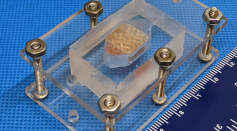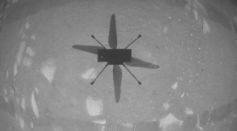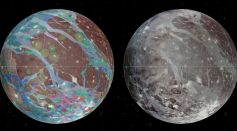Tags: NASA
NASA's First Megarocket Space Launch System to Carry Humans to the Moon Completed
Gaseous Planets Orbiting Bright Star Discovered: Citizen Scientists Finds Exoplanets With Sizes Like Neptune and Saturn
Mars Selfie: China Captures Coolest Photos of the Red Planet

NASA Approves Near-Earth Object Space Telescope; Will It Improve Planetary Defense Efforts?

NASA Awards 2 Wake Forest Teams for Printing 3-D Human Liver Tissues in a Lab

NASA Shares Stunning Photos of Merging Galaxies 140 Million Light-Years from Earth

NASA's Juno Spacecraft Pictures Mighty Jupiter Moon Ganymede in Close-up

Ingenuity Survives 7th Flight; NASA's Mars Helicopter Landed in a Brand New Spot!

NASA Juno Spacecraft Finally Flies Past Jupiter Moon Ganymede in a Wild Ride
Life on Venus: Will NASA Make This Possible on Earth's Twin Planet?

NASA Spills More Details About Missions to Venus, Earth, Mars, and Moon
NASA Explains What Makes Two Missions to Venus by 2030 Exciting

NASA’s Juno All Set to Make Closest Flyby to Jupiter’s Moon Ganymede
SpaceX Dragon Cargo Ship Docks at ISS: New Solar Arrays, Fresh Experiment Supplies Onboard

NASA-Funded CIBER-2 Sounding Rocket Identifies the Complete Count of Stars, Expected to Increase
Seven-Hour Spacewalk of Two Cosmonauts Part of ISS Preparation for Arrival of New Russian Module
SpaceX Dragon Spacecraft Sends Glow-in-the-Dark Baby Squids to the ISS for NASA Space Experiments

NASA Commands Martian Muck-Covered InSight Lander to Tidy Up; A Trick Developed for Sedentary Probe
NASA Selects Two Missions to Visit Venus for the First Time to Unveil Secrets of Earth's Evil Twin

New Zealand Partners With NASA to Help Grow Space Industry in the Country
Most Popular

Largest Known Volcanic Aquifer Discovered Beneath Oregon's Cascades

New 'Supergiant' Sea Bug Found in South China Sea, Named After Darth Vader

Mediterranean Sea Was Refilled by a Catastrophic Flood Millions of Years Ago

Mysterious Cosmic Waves That Sound Like Birds Detected in Unexpected Space Region




